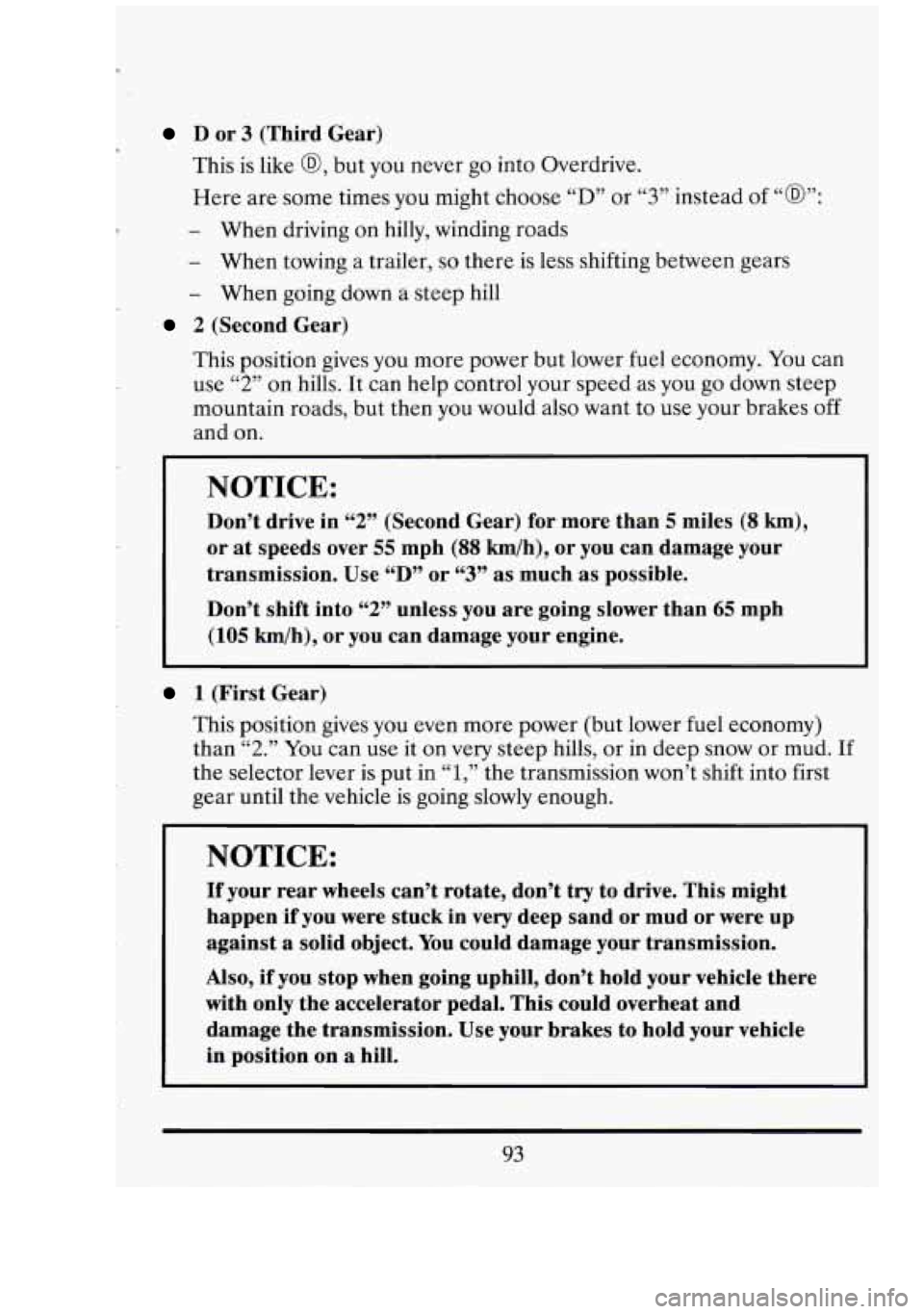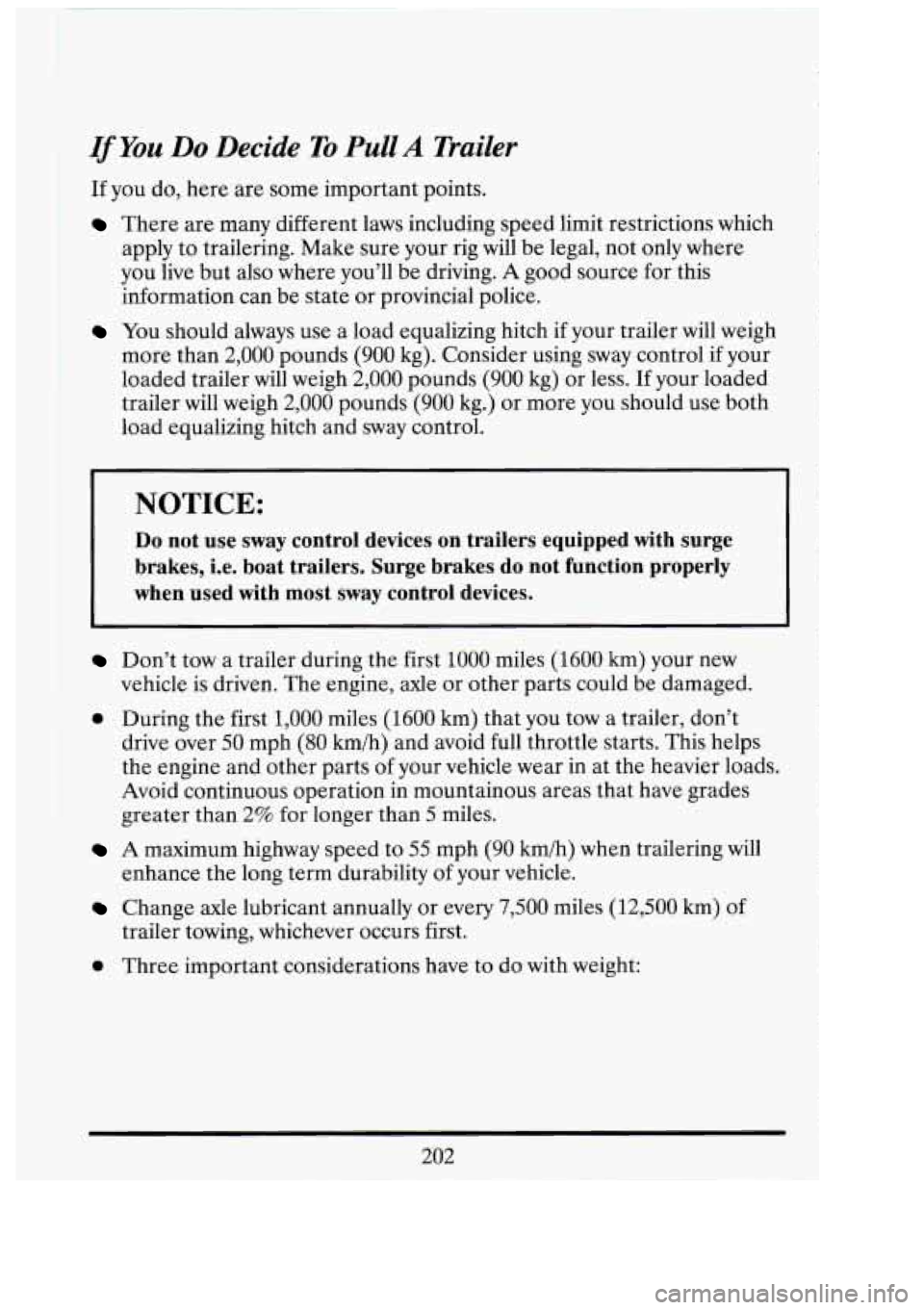Page 101 of 398
NOTICE:
Your engine is designed to work with the electronics in your
vehicle.
If you add electrical parts or accessories, you could
change the
way the fuel injection system operates. Before
adding electrical equipment, check with your dealer.
If you
don’t, your engine might not perform properly.
If you ever have to have your vehicle towed, see the part
of this
manual that tells how to do it without damaging your vehicle.
See “Towing Your Vehicle’’ in the Index.
I
L
DmNG THROUGH DEEP STMDING
WATER
NOTICE:
If you drive too quickly through deep puddles or standing water,
water can come in through your engine’s
air intake and badly
damage your engine.
If you can’t avoid deep puddles or standing
water, drive through them very slowly.
Page 106 of 398

D or 3 (Third Gear)
This is like
@, but you never go into Overdrive.
Here are some times you might choose
“D” or “3” instead of “@”:
- When driving on hilly, winding roads
- When towing a trailer, so there is less shifting between gears
- When going down a steep hill
2 (Second Gear)
This position gives you more power but lower fuel economy.
You can
use
2 on hills. It can help control your speed as you go down steep
mountain roads, but then you would also want to use your brakes off
and on. (6 77
NOTICE:
Don’t drive in “2” (Second Gear) for more than 5 miles (8 km),
or at speeds over 55 mph (88 km/h), or you can damage your
transmission. Use
“D” or “3” as much as possible.
Don’t shift into
“2” unless you are going slower than 65 mph
(105 km/h), or you can damage your engine.
1 (First Gear)
This position gives you even more power (but lower fuel economy)
than
“2.” You can use it on very steep hills, or in deep snow or mud. If
the selector lever is put in “1,” the transmission won’t shift into first
gear until the vehicle is going slowly enough.
NOTICE:
If your rear wheels can’t rotate, don’t try to drive. This might
happen
if you were stuck in very deep sand or mud or were up
against
a solid object. You could damage your transmission.
Also, if you stop when going uphill, don’t hold your vehicle there
with only the accelerator pedal. This could overheat and
damage the transmission. Use your brakes to hold your vehicle
in position on
a hill.
93
Page 107 of 398
TMLER TOWING PACMGE (OPTION)
If your Fleetwood is equipped with either V92 or V4P package, you can
increase your vehicle's trailer towing capability to
5,000 pounds (2270 kg)
or 7000 lbs. (3178 kg). To determine which package you have, see the
Service Parts Label located on the underside
of the trunk lid. These
packages include a trailering harness located
in the trunk, heavy-duty
engine and transmission cooling.
Also included are heavy-duty front and
rear springs, 2.93:l rear axle ratio and Eagle
GA P235/70R15 tires.
3
a,
I
I
P-NG BRAKE
The parking brake uses the brakes on the rear wheels.
To set the parking brake:
Hold the regular brake pedal down with your right foot. Push down the
parking brake pedal with your left foot.
If the ignition is on, the brake
system warning light will come
on.
I
94
Page 109 of 398
If you are on a hill: See “Parking on Hills” in the Index. That section
shows how to turn your front wheels.
If you are towing a trailer and are parking on any hill: See “Towing a
Trailer” in the Index. That section shows what to do first to keep the
trailer from moving.
SHIFTING INTO 44P” (PARK)
Steering Column Shift Lever
1. Hold the brake pedal down with your right foot.
E
1
n !fl
I
96
..
Page 114 of 398
- RUNNING YOUR ENGINE WHILE YOU’RE
PARKED
It’s better not to park with the engine running. But if you ever have to,
here are some things to know.
Follow the proper steps to be sure your vehicle won’t move.
See “Shifting
Into
‘P’ (Park)’’ in the Index.
101
If you are parking on a hill and if you’re pulling a trailer, also see “Towing
a Trailer” in the Index.
Page 119 of 398

A green arrow on the
instrument panel will
flash in the direction
of
the turn or lane
change.
To signal a lane change, just raise or lower the lever until the green arrow
starts to flash. Hold it there until you complete your lane change. The
lever will return by itself when you release it.
As you signal a turn or a lane change, if the arrows don’t flash but just
stay on, a signal bulb may be burned out and other drivers won’t see your
turn signal.
If a bulb is burned out, replace it to help avoid an accident. If the green
arrows don’t go on at all when you signal a turn, check the fuse (see
“Fuses” in the Index) and for burned-out bulbs.
If you have
a trailer towing option with added wiring for the trailer lights,
a different turn signal flasher is used. With this flasher installed, the
signal indicator will flash even if a turn signal bulb is burned out. Check
the front and rear turn signal lights regularly to make sure they are
working.
Operation of Lights
Although your vehicle’s lighting system (headlights, parking lights, fog
lamps, side marker lights and taillights) meets all applicable federal
lighting requirements, certain states and provinces may apply their own
lighting regulations that may require special attention before you operate
these lights.
For example, some jurisdictions may require that you operate your lower
beam lights with fog lamps at all times, or that headlights be turned on
whenever you must use your windshield wipers. In addition, most
106
-1 I
E,
3’
ii
i
-I
J
Page 214 of 398
TOWING A TRAILER
NOTICE:
Pulling a trailer improperly can damage your vehicle and result\
in costly repairs not covered by your warranty.
To pull a trailer
correctly, follow the advice in this section.
Your Cadillac is a passenger vehicle. Trailer towing can change the way
your vehicle performs on the road. The loads and forces created when
trailering subject the vehicle
to significant levels of stress.
Load pulling components such as the engine, transmission, rear axle,
wheel assemblies, and tires are forced to work harder against the drag of
the added weight. The engine is required to operate at relatively higher
speeds and under greater loads, which generates extra heat. Trailer
towing adds considerably to wind resistance which increases pulling
requirements.
All this means changes in:
Handling
Durability
Fuel Economy
201
Page 215 of 398

I
If You Do Decide To Pull A Trailer
If you do, here are some important points.
There are many different laws including speed limit restrictions which
apply to trailering. Make sure your rig
will be legal, not only where
you live but also where you’ll be driving.
A good source for this
information can be state or provincial police.
You should always use a load equalizing hitch if your trailer will weigh
more than
2,000 pounds (900 kg). Consider using sway control if your
loaded trailer will weigh
2,000 pounds (900 kg) or less. If your loaded
trailer will weigh
2,000 pounds (900 kg.) or more you should use both
load equalizing hitch and sway control.
NOTICE:
Do not use sway control devices on trailers equipped with surge
brakes, i.e. boat trailers. Surge brakes
do not function properly
when used with most sway control devices.
Don’t tow a trailer during the first 1000 miles (1600 km) your new
vehicle is driven. The engine, axle or other parts could be damaged.
5 During the first 1,000 miles (1600 km) that you tow a trailer, don’t
drive over
50 mph (80 km/h) and avoid full throttle starts. This helps
the engine and other parts
of your vehicle wear in at the heavier loads.
Avoid continuous operation in mountainous areas that have grades
greater than
2% for longer than 5 miles.
A maximum highway speed to 55 mph (90 km/h) when trailering will
enhance the long term durability of your vehicle.
Change axle lubricant annually or every 7,500 miles (12,500 km) of
trailer towing, whichever occurs first.
0 Three important considerations have to do with weight:
202
o/
I
I
c
nl
I
‘p’
u,